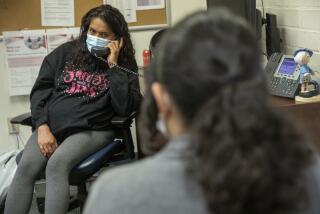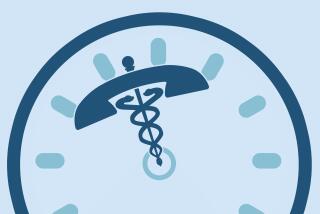Mobile clinic’s return puts focus on follow-up care
- Share via
Doctors and other medical personnel who volunteered last August at the largest free health clinic ever held in Los Angeles could practically watch as their patients slipped through the holes in the county’s safety net.
Among the 6,300 uninsured and underinsured seeking care at the Forum in Inglewood last year, Dr. Natalie Nevins diagnosed a 58-year-old woman as having diabetes and dangerously high blood sugar. The woman, who had recently lost her job and health insurance, refused to be hospitalized, afraid of the expense.
“I said, ‘If I can find a clinic that will take you now, that will get your blood sugar under control, will you go?’ ” said Nevins, director of medical education at Downey Regional Medical Center.
The woman agreed. But the two community clinics Nevins called wouldn’t take her -- they were already overwhelmed.
As the nonprofit Remote Area Medical, or RAM, prepares to return in April -- as well as venture into Chicago and Washington, D.C., later this year -- local leaders acknowledge that the first L.A. clinic exposed not only the depth of need for low-cost healthcare but also a major weakness in the ability to secure follow-up care.
“It shakes up a system that’s pretty delicate,” Louise McCarthy, vice president of governmental affairs at the Community Clinic Assn. of Los Angeles County, said of the large-scale clinic, which her group helped organize.
“We’ve been strengthening our networks and trying to be savvy about how to handle this.”
Last year, by the time some RAM patients found a traditional clinic for follow-up care, they had lost their medical records, forgotten what tests they took and had to be retested, according to organizers and clinic staff. In some cases, backup copies of patients’ medical records had been misplaced by volunteers, according to Don Manelli, who is in charge of production for RAM’s clinics.
“Despite our best efforts, it didn’t pan out,” McCarthy said of follow-up care.
As RAM organizers get ready to return to the site of their largest and most urban clinic to date, this time at the Los Angeles Sports Arena from April 27 to May 3, efforts are underway to ensure that patients don’t leave the mobile clinic with no way to seek additional care.
Filling the gap remains crucial, organizers say, since many of the recent national healthcare reforms will take years to enact.
Volunteers and L.A. County employees are contacting Los Angeles-area clinics and dentists, as well as those in Orange and Ventura counties, to compile a list of those able to take new patients.
When patients register for the mobile clinic, they will be issued a wristband, identification number and bar code to track their records. Before they leave, patients will be screened by volunteers and matched with a local healthcare provider. Volunteers will then fax or e-mail their medical records to that provider.
Exactly how many of those treated at the Forum needed additional care and how many got it remains unclear.
“It was kind of an ad hoc process,” said Manelli, whose group has organized more than 600 mobile clinics internationally during the last 25 years.
Typically, about 5% to 8% of those treated at RAM clinics require follow-up care, organizers said.
But the Knoxville, Tenn.-based group had never treated patients in as large an urban area as Los Angeles, where studies estimate about 30% of the population is uninsured.
At the Forum, far more patients were in need of follow-up care for abnormal test results and chronic conditions, according to Manelli.
For example, of 600 women who received Pap smears at the Forum, 160 -- about 27% -- had abnormal results that required follow-up care, he said.
In some cases, doctors used personal connections to get a patient an appointment, as Nevins did to help the diabetic woman turned down by the overbooked clinics.
At the JWCH Institute clinic in Bell Gardens, Nevins said, the woman received free medication to stabilize her blood sugar. She returned to the Forum the next day to see a dentist and thank Nevins for saving her life.
But Nevins said she was unable to make such appointments for every patient she saw during the eight-day clinic and was sure many failed to seek follow-up care.
“If you put up enough roadblocks, they’re going to give up,” she said.
The county’s roughly 600 clinics and 130 county-contracted clinics are even more overwhelmed than last year, according to Carol Meyer, the county heath system’s chief network officer. During the last year, they have had to eliminate many dental and eye-care services because of millions of dollars in state cuts to Denti-Cal and Medi-Cal, she said.
“We can’t handle all the patients we have now, and it’s getting worse with the economy,” Meyer said. “People are losing their jobs, their insurance, and we’re the last resort.”
Some county cancer clinics have seen 20% to 33% more chemotherapy visits during the last year, Meyer said, and the wait to see a specialist can top six months. The county’s Department of Health Services has a $200-million budget shortfall this fiscal year, including $30 million from state Medi-Cal cuts, and that’s expected to grow to $625 million next year.
“All we can do is try to be more efficient and try to get more patients into the same clinic hours,” Meyer said. “But there’s only so much you can absorb. So the waiting times get longer.”
Improving the RAM referral process will get patients a place in line but won’t guarantee treatment, said Abbe Land, co-chief executive of the Saban Free Clinic in Los Angeles, where patients have to wait up to two months to get a filling replaced or other basic dental care.
“The reality is when you have a weeklong clinic, it is not a cure-all for an entrenched healthcare problem,”said Yolanda Vera, health deputy to Supervisor Mark Ridley-Thomas, whose district includes South Los Angeles and whose offices helped organize the free mobile clinics. “We’ll do the best we can to make sure people have the right documents and know where to go and don’t fall through the cracks.”
molly.hennessy-fiske @latimes.com
More to Read
Sign up for Essential California
The most important California stories and recommendations in your inbox every morning.
You may occasionally receive promotional content from the Los Angeles Times.














